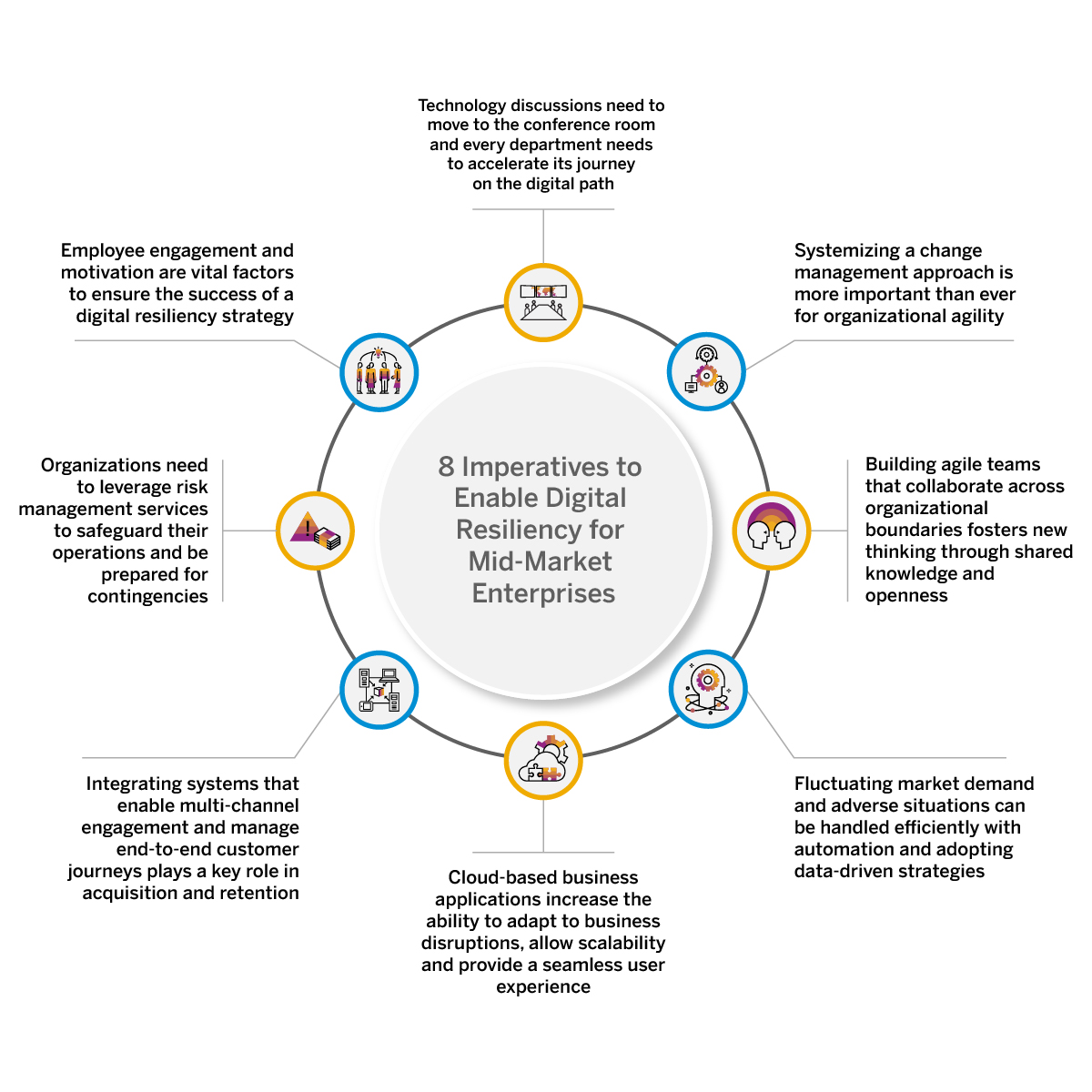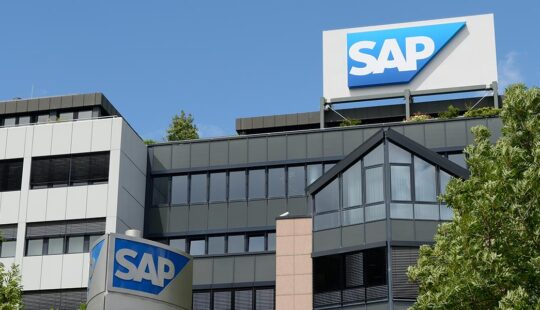The pandemic ushered in a period of extraordinary change for the global business community. As organizations worldwide struggled to stay afloat, it became clear that digital was the lifeline that would help them recover, balance demand with capacity and even prepare for the volatile future ahead. However, large enterprises had a head start in this regard; many of them were able to implement a digital transformation strategy for their business in the early days of the pandemic. For smaller organizations and mid-market enterprises, the pandemic was a wake-up call that made them realize the need to adopt digitalization and leverage digital transformation benefits rapidly.
Mid-market segment: Looking to bounce back after a Crisis
The mid-market sector was the hardest hit during the pandemic. These midsize businesses had to improvise with limited resources and compete against larger players with operational and financial flexibility. Sharply aware of the consequences of being left behind in the digital race, these businesses are now embracing technology to rethink strategies, enhance customer experiences, utilize employee skills more efficiently, and ensure business continuity and growth even in a crisis.
This was among the multiple insights provided by an IDC Infobrief commissioned by SAP that aimed to understand the state of mid-market enterprises in India after the Covid-19 second wave. The study covered over 350 mid-market enterprises across industries such as chemicals, industrial manufacturing, life sciences (including pharma and pharma manufacturing), professional services (including IT/IT-enabled Services), retail and consumer packaged goods and EC&O (engineering, construction, and operations). Annual revenues for these companies ranged from INR 500 crore to INR 2,000 crore. Half of the respondents were C-level executives, with the rest holding positions such as Director and above in their organizations.
As per the survey,
- Around 74% of the mid-market enterprises surveyed will move more applications to the cloud.
- A massive 68% of the firms expect to either retain or increase their IT spending in 2022, driven by the need to adopt digital technologies.
- This digital vision is consequently fuelling enthusiasm and hopes of a strong recovery. By the end of 2021, around 75% of the mid-market businesses surveyed expect their operations to be back to pre-pandemic levels.

Clearly, mid-market segment companies are planning to be strong contenders in their industries in the post-pandemic world. For this, they require a level of digital resilience that allows them to proactively fend off dangers and disruptions more effectively than their competitors.
Digital Resiliency: Driving the Indian mid-market sector forward
Digital resilience is the ability of a company to quickly adapt to business turmoil by using digital skills to drive recovery, growth and profitability, even during changing situations.
While mid-market enterprises focus on optimizing their operational performance in the short term, CEOs point out that revenue diversification and IT infrastructure renewal remain their top digital priorities in the long term. This can be achieved by prioritizing all dimensions of digital resiliency such as operational, workforce and customer, brand and reputation, leadership and organization, and financial resiliency.
- Operational Resiliency: Improving operational efficiency is a major short-term business goal for most C-level executives. One way to achieve this is by adopting an ERP system that offers end-to-end visibility into operations across different departments. Around 58% of mid-market enterprises have such an ERP system now.
Apart from an ERP system, there is also a need for digital transformation for business in areas such as customer services, supply chain functions and backend processes to achieve higher productivity levels and minimize the possibility of errors. - Workforce Resiliency: Enterprises have realized the benefits of a motivated workforce, with good employees being one of the best strategies to increase growth and scale operations. Employers are becoming more engaged and assuming greater responsibility for their employees’ safety and emotional and physical wellbeing. When not physically together, workforce engagement requires more thoughtful design, practice, and measurement. Consequently, almost 50% of enterprises are considering an integrated approach towards workforce resiliency, compared to just 36% in the pre-pandemic era.
- Customer Resiliency: With digital transformation, any mid-market organization can provide seamless and enjoyable customer journeys across channels. As the customer experience becomes a vital indicator of organizational health, around 40% of enterprises are adopting an end-to-end approach to manage customer journeys. Hi-tech platforms, CRM systems, chatbots and AR-VR rich media are set to become an important part of this digital transformation strategy.
- Financial Resiliency: Having sophisticated systems and robust processes that provide timely insights is critical for building financial resilience in mid-market enterprises. The IDC Infobrief commissioned by SAP shows that 58% of the Indian mid-market enterprises have introduced scorecards, visualization and simulations to generate detailed financial analysis reports. These help minimize future bottlenecks by providing the base required to make data-driven forecasts.
- Leadership Resiliency: A truly forward-looking company needs to build resiliency at the top. In the face of dynamic market conditions and volatile situations, an enterprise should be able to alter processes and methods and retain employee and customer trust. A whopping 83% of enterprises are focusing on resiliency objectives like business continuity.
- Brand and Reputation Resiliency: An expanding threat surface and the increasing number of attacks on mid-market enterprises makes cybersecurity a top consideration for this segment. Around 74% of enterprises will either spend more or retain their current spend on IT security and related issues.
The road to Digital Resiliency: What mid-market enterprises need to do?
India’s mid-market segment can become the engine of growth if digital resiliency is adopted to compete with big businesses. While digitalization is not a permanent cure for all the problems that affect business in today’s economy, it is a foolproof solution that can help a mid-market enterprise compete and win in the new normal.
Despite this knowledge, many enterprises hesitate to fully embrace digitalization and digital transformation because of resource crunch and the absence of a clear roadmap. Here are some practical ways a mid-market enterprise can create a thriving environment for digital resilience.
- While midsize companies appreciate the role that technology plays in digital resilience, most are still hesitant in making it an integral part of their day-to-day operations. To overcome this, technology discussions need to be moved to the conference room and every department needs to accelerate its journey on the digital path.
- Change management is a vital aspect of building digital resiliency. Change readiness is determined by a company’s culture, dedication, and ability to achieve and maintain the goal. In a time of competing priorities, systemizing a change management approach is more important than ever for organizational agility.
- It’s critical to prioritize and create conditions that support experimentation after opening corporate culture to innovation and creativity. Build agile teams that collaborate across organizational boundaries on a daily basis to foster new thinking through shared knowledge and openness. Acquire the ability to make swift decisions. Rapidly adapting to business shocks is the key to digital resilience.
- Lack of operational automation is one of the main reasons Indian midsize companies are still struggling. Fluctuating market demand and any adverse situation can be handled efficiently with automation and adopting data-driven strategies.
- Shifting to cloud–based business applications increases the ability to adapt to business disruptions, allows scalability and flexibility and provides a seamless user experience. Mid-market enterprises have identified the integration of new-age technology, enhanced business agility and innovation, a competitive edge and improved time to market as some of the other top drivers behind cloud adoption in the IDC Infobrief.
- Integrating systems that enable multi-channel engagement and manage end-to-end customer journeys plays a key role in customer acquisition and retention. These systems, if managed smartly, can effectively contribute to an organization’s capability of outliving its competition. Make integrated multi-channel marketing and sales a priority and find the correct combination of online and offline marketing, sales, and service. Create a user-friendly website and leverage different digital customer experience and analytics solutions.
- With remote and hybrid cloud models becoming increasingly popular, the need for a secure cloud architecture has become pronounced. Organizations need to leverage risk management services to safeguard their operations and be prepared for contingencies.
- Employee engagement and motivation are vital factors to ensure the success of a digital resiliency strategy. CEOs should focus on providing necessary knowledge resources and conduct continuous learning programs to enable their employees to work efficiently.

In conclusion
The opportunities for mid-market firms are boundless; however, they must take advantage of today’s booming economy to revamp their operations for long-term viability. For this, their capacity to predict risks, increase efficiencies and undertake change is crucial. A way to do this is by embracing digitalization and building Digital Resiliency. To find out how to kickstart your journey to becoming digitally resilient, download the IDC Infobrief commissioned by SAP on ‘State of Mid-Market Enterprises in India, a Perspective on Digital Resiliency’.
All of the above data points are derived from ‘IDC InfoBrief commissioned by SAP, The State of Midmarket Enterprises in India, A Perspective on Digital Resiliency, December 2021, Doc.#AP241284IB



